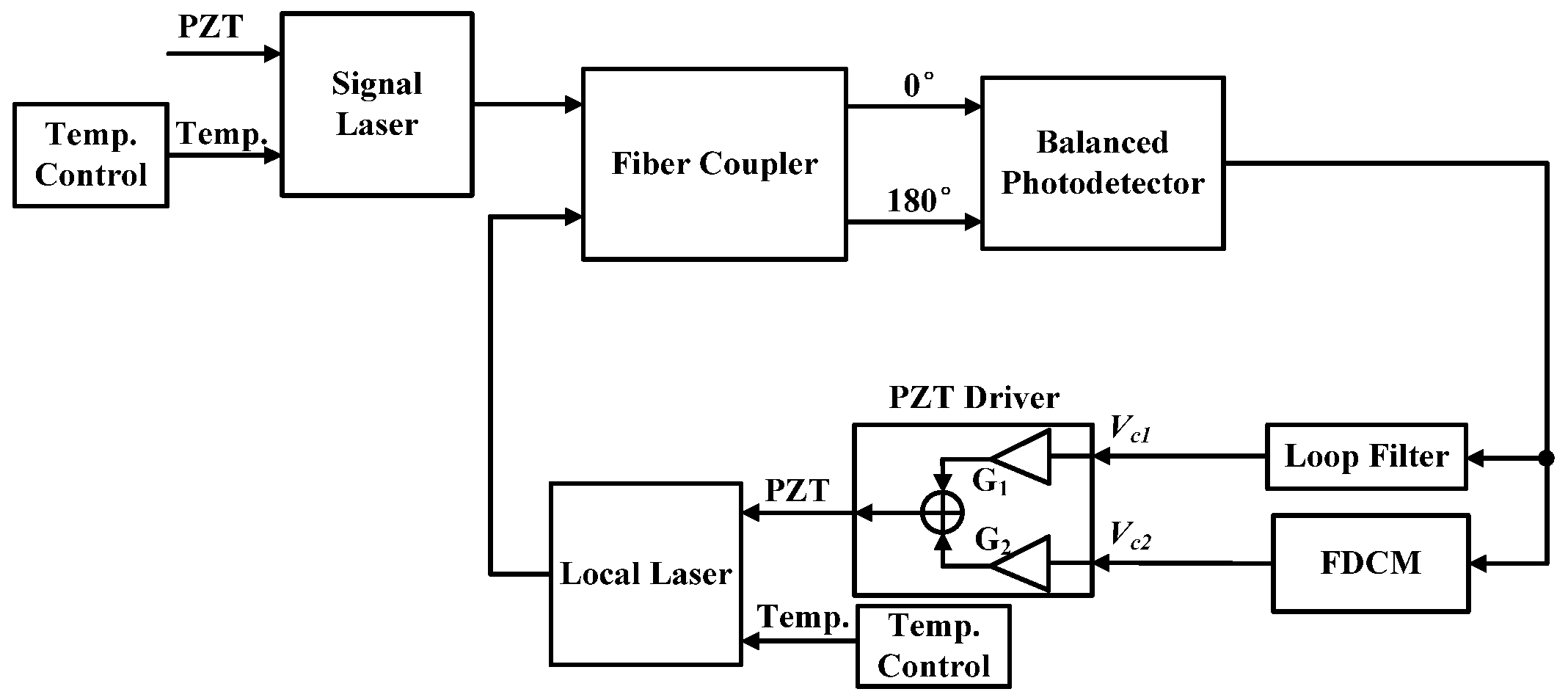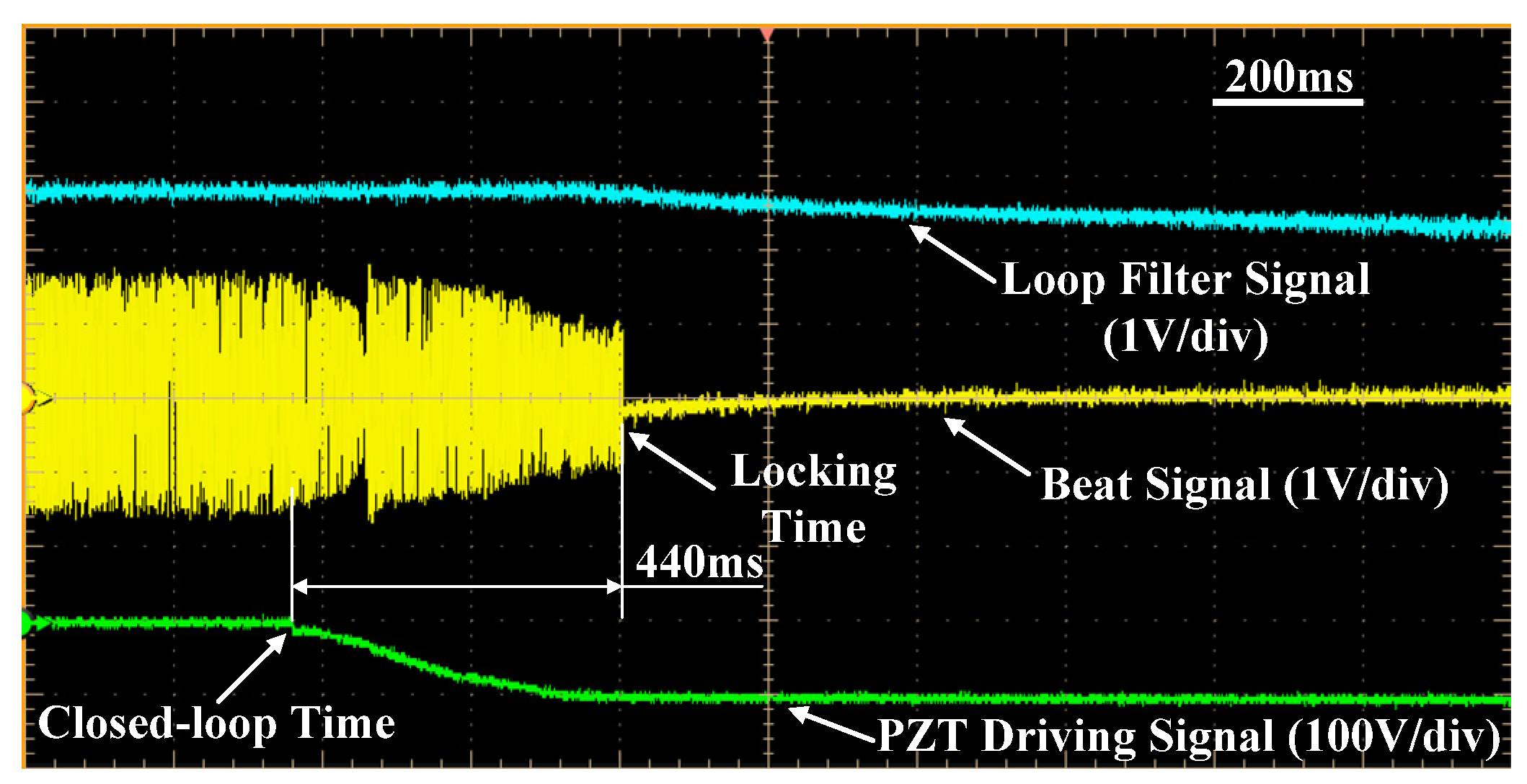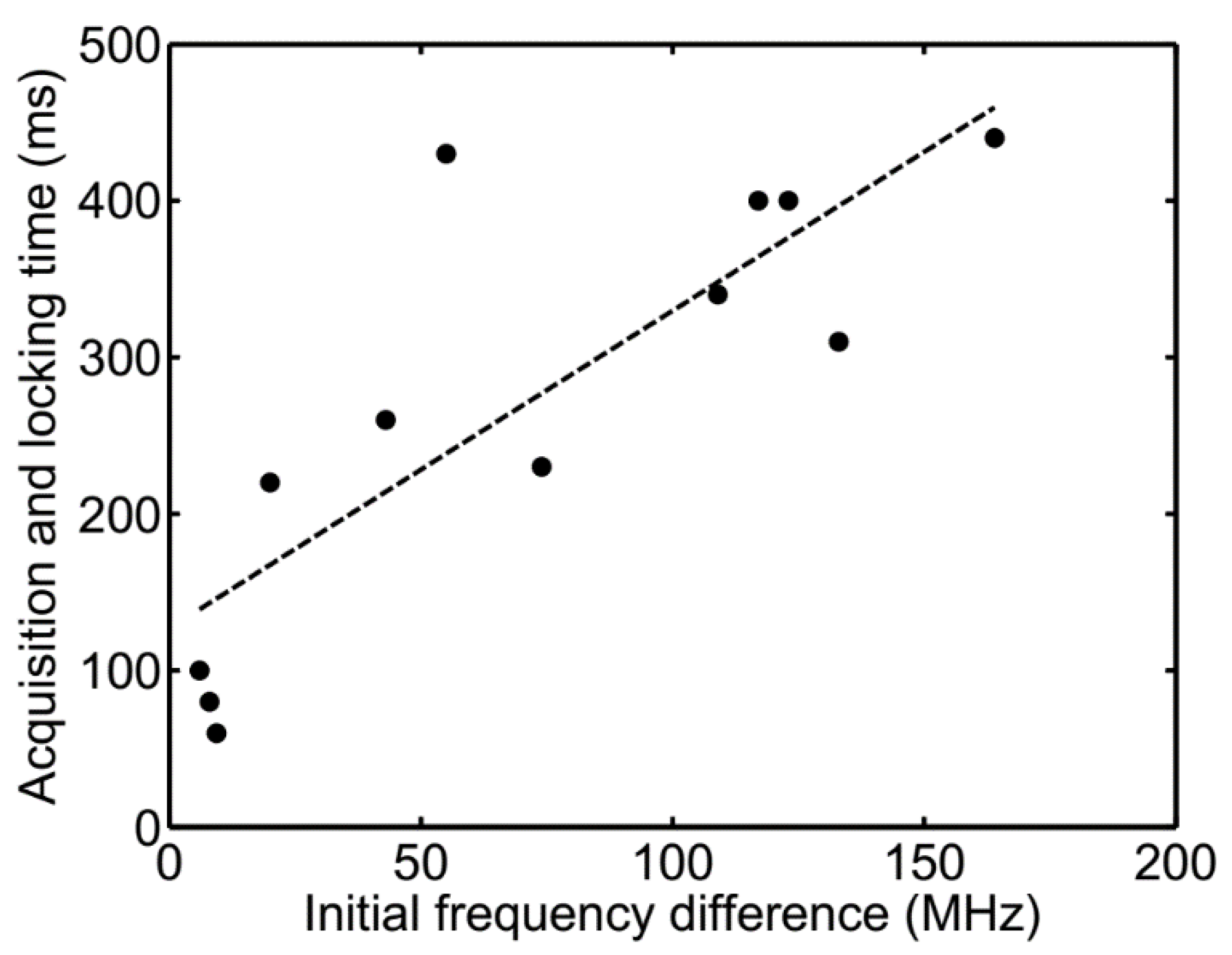Fast Frequency Acquisition and Phase Locking of Nonplanar Ring Oscillators
Abstract
:1. Introduction
2. Design of the OPLL
3. Principle of Frequency Acquisition
4. Experimental Results
5. Conclusions
Acknowledgments
Author Contributions
Conflicts of Interest
References
- Smutny, B.; Kaempfner, H.; Muehlnikel, G.; Sterr, U.; Wandernoth, B.; Heine, F.; Hildebrand, U.; Dallmann, D.; Reinhardt, M.; Freier, A.; et al. 5.6 Gbps Optical Intersatellite Communication Link. In Proceedings of the SPIE—The International Society for Optical Engineering, San Jose, CA, USA, 24 February 2009; No. 7199. pp. 601–608. [Google Scholar]
- Tröndle, D.; Pimentel, P.M.; Rochow, C.; Zech, H.; Muehlnikel, G.; Heine, F.; Meyer, R.; Philipp-May, S.; Lutzer, M.; Benzi, E.; et al. Alphasat-Sentinel-1A Optical Inter-Satellite Links: Run-Up For The European Data Relay Satellite System. In Proceedings of the SPIE—The International Society for Optical Engineering, San Francisco, CA, USA, 15 March 2016; No. 9739. pp. 201–206. [Google Scholar]
- Gregory, M.; Troendle, D.; Muehlnikel, G.; Heine, F.; Meyer, R.; Lutzer, M.; Czichy, R. 3 Years Coherent Space to Ground Links: Performance Results And Outlook For The Optical Ground Station Equipped with Adaptive Optics. In Proceedings of the SPIE—The International Society for Optical Engineering, San Francisco, CA, USA, 19 March 2013; No. 8610. pp. 401–413. [Google Scholar]
- Saucke, K.; Seiter, C.; Heine, F.; Gregory, M.; Tröndle, D.; Fischer, E.; Berkefeld, T.; Feriencik, M.; Feriencik, M.; Richter, I.; et al. The Tesat Transportable Adaptive Optical Ground Station. In Proceedings of the SPIE—The International Society for Optical Engineering, San Francisco, CA, USA, 15 March 2016; No. 9739. pp. 601–611. [Google Scholar]
- Kang, H.; Zhang, H.; Wang, D. Thermal-induced refractive-index planar waveguide laser. Appl. Phys. Lett. 2009, 95, 181102. [Google Scholar]
- Scholtz, A.L.; Leeb, W.R.; Philipp, H.K.; Bonek, E. Infra-Red Homodyne Receiver with Acousto-Optically Controlled Local Oscillator. Electron. Lett. 1983, 19, 234–235. [Google Scholar] [CrossRef]
- Norimatsu, S.; Iwashita, K.; Noguchi, K. 10 Gbit/s Optical PSK Homodyne Transmission Experiments Using External Cavity DFB LDs. Electron. Lett. 1990, 26, 648–649. [Google Scholar] [CrossRef]
- Arafin, S.; Simsek, A.; Kim, S.; Dwivedi, S.; Liang, W.; Eliyahu, D.; Klamkin, J.; Matsko, A.; Johansson, L.; Maleki, L.; et al. Towards Chip-Scale Optical Frequency Synthesis Based on Optical Heterodyne Phase-Locked Loop. Opt. Express 2017, 25, 681–695. [Google Scholar] [CrossRef] [PubMed]
- Balakier, K.; Fice, M.J.; Ponnampalam, L.; Seeds, A.J.; Renaud, C.C. Monolithically Integrated Optical Phase Lock Loop for Microwave Photonics. J. Lightwave Technol. 2014, 32, 3893–3900. [Google Scholar] [CrossRef]
- Lu, M.; Park, H.; Bloch, E.; Johansson, L.A.; Rodwell, M.J.; Coldren, L.A. An Integrated Heterodyne Optical Phase-Locked Loop with Record Offset Locking Frequency. In Proceedings of the 2014 Optical Fiber Communication Conference and Exhibition (OFC), San Francisco, CA, USA, 9–13 March 2014. [Google Scholar]
- Herzog, F. An Optical Phase Locked Loop for Coherent Space Communications. Ph.D. Thesis, Swiss Federal Institute of Technology, Zurich, Switzerland, 2006. [Google Scholar]
- Ando, T.; Haraguchi, E.; Tajima, K.; Hirano, Y.; Hanada, T.; Yamakawa, S. Optical Homodyne BPSK Receiver with Doppler Shift Compensation for LEO-GEO Optical Communication. In Proceedings of the 2013 Conference on Lasers and Electro-Optics Pacifc Rim, Kyoto, Japan, 30 June–4 July 2013. [Google Scholar]
- Wang, Y.; Qiu, Q.; Shi, S.; Su, J.; Liao, Y.; Xiong, C. High-precision optical phase locking based on wideband acousto-optical frequency shifting. Chin. Opt. Lett. 2014, 12, 021402. [Google Scholar] [CrossRef]
- Shu, G.; Choi, W.S.; Saxena, S.; Anand, T.; Elshazly, A.; Hanumolu, P.K. 8.7 A 4-to-10.5 Gb/s 2.2 mW/Gb/s continuous-rate digital CDR with automatic frequency acquisition in 65 nm CMOS. In Proceedings of the 2014 IEEE Interational Solid-State Circuits Conference Digest of Technical Papers (ISSCC), San Francisco, CA, USA, 9–13 February 2014; pp. 150–151. [Google Scholar]
- Huang, S.; Cao, J.; Green, M.M. An 8.2 Gb/s-to-10.3 Gb/s Full-Rate Linear Referenceless CDR Without Frequency Detector in 0.18 μm CMOS. IEEE J. Solid State Circuits 2015, 50, 2048–2060. [Google Scholar] [CrossRef]






© 2017 by the authors. Licensee MDPI, Basel, Switzerland. This article is an open access article distributed under the terms and conditions of the Creative Commons Attribution (CC BY) license (http://creativecommons.org/licenses/by/4.0/).
Share and Cite
Wang, Y.; Wang, C.; Tao, Y.; Liu, Y.; Zhou, Q.; Su, J.; Wang, Z.; Shi, S.; Qiu, Q. Fast Frequency Acquisition and Phase Locking of Nonplanar Ring Oscillators. Appl. Sci. 2017, 7, 1032. https://doi.org/10.3390/app7101032
Wang Y, Wang C, Tao Y, Liu Y, Zhou Q, Su J, Wang Z, Shi S, Qiu Q. Fast Frequency Acquisition and Phase Locking of Nonplanar Ring Oscillators. Applied Sciences. 2017; 7(10):1032. https://doi.org/10.3390/app7101032
Chicago/Turabian StyleWang, Yunxiang, Chen Wang, Yangping Tao, Yang Liu, Qiang Zhou, Jun Su, Zhiyong Wang, Shuangjin Shi, and Qi Qiu. 2017. "Fast Frequency Acquisition and Phase Locking of Nonplanar Ring Oscillators" Applied Sciences 7, no. 10: 1032. https://doi.org/10.3390/app7101032





